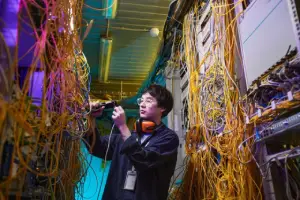Trip Over Exposed Cable in CCTV Control Room
The CCTV control room is the heart of many security operations. It’s where incidents are spotted, decisions are made, and responses are coordinated. But it’s also often packed with desks, monitors, radios, and a web of cables.
An exposed or poorly managed cable may seem harmless—but HSE statistics show that around 20% of workplace injuries reported under RIDDOR come from slips, trips and falls, many linked to simple housekeeping issues like wires. For a security officer, one trip in the control room could mean more than a bruised knee—it could knock you into sensitive equipment, delay a response to an emergency, or even trigger a major system outage.

Under the Health and Safety at Work Act 1974 and Workplace (Health, Safety and Welfare) Regulations 1992, employers must provide a safe environment. At the same time, the SIA Standards of Professional Behaviour expect you, as a licensed officer, to remain vigilant and act responsibly in preventing hazards.
Tip: If you see a hazard in the control room, don’t think “it’s only staff back here.” A fall behind the scenes can be just as damaging as one in public view.
Step-by-Step: Responding to Exposed Cables
When you identify a cable hazard in a CCTV control room, here’s how to respond professionally:
Spot and Assess
Look for cables trailing across walkways, loose connections, or damaged coverings.
Ask: Could someone trip if they entered in a hurry or during an emergency?
Act Immediately
If safe to do so, move or temporarily secure the cable (e.g. with cable covers or tape).
Restrict access to the hazard area until it’s safe.
Report Promptly
Log the hazard to your supervisor and control room manager.
Escalate to facilities or IT for a proper fix—temporary measures aren’t enough.
Follow Up
Check that the repair has been made.
Document your actions in the site hazard or accident log to show due diligence.
Real-World Example
A control room officer at a retail centre noticed colleagues tripping on a loose power cable running to a temporary monitor. One evening, an officer stumbled and nearly pulled the screen off the desk. The hazard was reported and logged, and the facilities team later installed under-desk cable trays and rubber floor covers.
The result? A safer control room, no more near misses, and smoother shift handovers without officers needing to “step over” cables.
Consequences of Ignoring the Hazard
For officers: A trip could cause broken bones, concussions, or musculoskeletal injuries, leading to sick leave.
For operations: Falling into equipment might disconnect CCTV feeds, radios, or alarms—delaying emergency response.
For compliance: Repeated hazards without correction could breach HSE requirements and expose the employer to enforcement action or fines.
For professionalism: Ignoring risks undermines your reputation as a trusted SIA-licenced officer.
Remember: Every unchecked hazard is a liability—for you, your team, and your employer.
Managing an Incident if Someone Trips
Even with good vigilance, sometimes accidents happen. If a colleague or visitor trips over a cable, your response matters.
Stay calm: Check for injuries and call for a first aider if required.
Secure the scene: Stop others from moving through until the hazard is controlled.
Record and report: Log both the incident and the hazard.
Example: During a night shift, a supervisor tripped over a trailing lead. You assisted them, placed a temporary cover, and reported the issue to facilities for urgent correction.
Tip: Always treat a workplace trip as potentially serious—even if the casualty insists they’re fine. Delayed injuries are common.
Working with IT and Facilities
Many cable issues are linked to temporary setups or equipment faults. Security officers may not be allowed to fix these permanently, but you can make sure the right teams step in.
Communicate clearly: Report the exact location and nature of the hazard.
Request urgency: Stress the impact on safety and operations if left unfixed.
Follow through: Confirm the repair has been completed.
Example: You noticed an extension cable powering several monitors was overloaded and across a walkway. You logged it with facilities, who replaced it with fixed trunking and sockets.
Tip: Build good relationships with IT and facilities staff—quick responses often depend on professional teamwork.
Prevention Through Good Housekeeping
Most cable hazards come down to one thing: poor housekeeping. Taking simple, routine steps can prevent most risks before they happen.
Keep walkways clear of temporary equipment.
Coil or tie up spare leads.
Ensure regular inspections are part of daily checks.
Example: Before starting your shift, you notice a vacuum left in the control room with its lead across the floor. You unplug it, coil the cable neatly, and store it safely.
Tip: Treat the control room like a high-risk zone. If you wouldn’t accept it on a public shop floor, don’t accept it behind the scenes.
Key Considerations for Officers
Stay observant: control rooms feel “safe,” but hazards are often hidden in plain sight.
Work as a team: raise issues with supervisors and facilities—don’t try to “make do” with unsafe setups.
Prioritise professionalism: your calm, proactive response shows competence and protects your SIA licence.
Build habits: include cable checks in your routine patrol of the control room before and after shifts.
Tip: Think of cable management as part of “site security.” If the control room is compromised by poor housekeeping, your entire operation is at risk.
Safety Starts Where You Stand
A trip in the CCTV control room isn’t “just an accident”—it’s a warning sign. Exposed cables can injure colleagues, knock out vital systems, and put your whole operation at risk. The good news? Every one of these hazards is preventable.
By keeping your eyes open, acting fast, and pushing for proper fixes, you’re not only protecting people—you’re protecting the heartbeat of site security.
That’s what sets a professional officer apart: the confidence to step up, secure the area, and keep everything running safely.
Tip: Think of every hazard you remove as one more shift that ends safely, one more colleague who goes home unhurt, and one more reason management can trust you.

